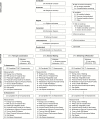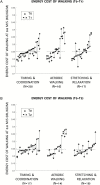Randomized Controlled Trial of Exercise to Improve Walking Energetics in Older Adults
- PMID: 30480143
- PMCID: PMC6177056
- DOI: 10.1093/geroni/igy022
Randomized Controlled Trial of Exercise to Improve Walking Energetics in Older Adults
Abstract
Background and objectives: Mobility limitation is common and has been linked to high energetic requirements of daily activities, including walking. The study objective was to determine whether two separate forms of exercise could reduce the energy cost of walking and secondary outcomes related to activity and participation domains among older adults with mobility limitation.
Research design and methods: Community-dwelling older adults with self-reported mobility limitation (n = 72) were randomized to 12 weeks of twice-weekly, group-based, instructor-led timing and coordination, aerobic walking, or stretching and relaxation (active control) programs. The primary outcome was the energy cost of walking (mL O2/kg/m), assessed by a 5-minute treadmill walking test (0.8 m/s). Secondary outcomes were fatigability, physical activity, endurance, physical function, and life-space. Baseline-adjusted ANCOVAs were used to determine mean differences between exercise and control groups at 12 and 24 weeks.
Results: Exercise session attendance was high: 86% for timing and coordination, 81% for aerobic walking, and 90% for stretching and relaxation. At 12 weeks, timing and coordination reduced the mean energy cost of walking by 15% versus stretching and relaxation (p = .008). Among those with high baseline cost, timing and coordination reduced mean energy cost by 20% versus stretching and relaxation (p = .055). Reductions were sustained at 24 weeks. Aerobic walking had no effect on the energy cost of walking at 12 or 24 weeks. At 12 weeks, there was a trend toward faster gait speed (by 0.1 m/s) in timing and coordination versus stretching and relaxation (p = .074). Fatigability, physical activity, endurance, physical function, and life-space did not change with timing and coordination or aerobic walking versus stretching and relaxation at 12 or 24 weeks.
Discussion and implications: Twelve weeks of timing and coordination, but not aerobic walking, reduced the energy cost of walking among older adults with mobility limitation, particularly among those with high baseline energy cost; reductions in energy cost were sustained following training cessation. Timing and coordination also led to a trend toward faster gait speed.
Keywords: Elderly; Energy cost of walking; Fatigability; Gait speed; Timing and coordination training.
Figures


Similar articles
-
Comparing Two Types of Exercise Classes to Help Older Adults Improve Walking Ability [Internet].Washington (DC): Patient-Centered Outcomes Research Institute (PCORI); 2018 Mar. Washington (DC): Patient-Centered Outcomes Research Institute (PCORI); 2018 Mar. PMID: 36924509 Free Books & Documents. Review.
-
Effect of Timing and Coordination Training on Mobility and Physical Activity Among Community-Dwelling Older Adults: A Randomized Clinical Trial.JAMA Netw Open. 2022 May 2;5(5):e2212921. doi: 10.1001/jamanetworkopen.2022.12921. JAMA Netw Open. 2022. PMID: 35604689 Free PMC article. Clinical Trial.
-
Effectiveness of a Timing and Coordination Group Exercise Program to Improve Mobility in Community-Dwelling Older Adults: A Randomized Clinical Trial.JAMA Intern Med. 2017 Oct 1;177(10):1437-1444. doi: 10.1001/jamainternmed.2017.3609. JAMA Intern Med. 2017. PMID: 28806436 Free PMC article.
-
Impact of exercise to improve gait efficiency on activity and participation in older adults with mobility limitations: a randomized controlled trial.Phys Ther. 2011 Dec;91(12):1740-51. doi: 10.2522/ptj.20100391. Epub 2011 Oct 14. Phys Ther. 2011. PMID: 22003158 Free PMC article. Clinical Trial.
-
Age-related changes in gait biomechanics and their impact on the metabolic cost of walking: Report from a National Institute on Aging workshop.Exp Gerontol. 2023 Mar;173:112102. doi: 10.1016/j.exger.2023.112102. Epub 2023 Jan 21. Exp Gerontol. 2023. PMID: 36693530 Free PMC article. Review.
Cited by
-
Interventions to improve outdoor mobility among people living with disabilities: A systematic review.Campbell Syst Rev. 2024 Jun 14;20(2):e1407. doi: 10.1002/cl2.1407. eCollection 2024 Jun. Campbell Syst Rev. 2024. PMID: 38882933 Free PMC article. Review.
-
Role of Walking Energetics and Perceived Fatigability Differs by Gait Speed: The Study of Muscle, Mobility and Aging (SOMMA).J Gerontol A Biol Sci Med Sci. 2024 Sep 1;79(9):glae187. doi: 10.1093/gerona/glae187. J Gerontol A Biol Sci Med Sci. 2024. PMID: 39066507 Free PMC article.
-
Multidimensional interventions to increase life-space mobility in older adults ranging from nursing home residents to community-dwelling: a systematic scoping review.BMC Geriatr. 2023 Jul 6;23(1):412. doi: 10.1186/s12877-023-04118-3. BMC Geriatr. 2023. PMID: 37415132 Free PMC article.
-
The Association of Mobility Determinants and Life Space Among Older Adults.J Gerontol A Biol Sci Med Sci. 2022 Nov 21;77(11):2320-2328. doi: 10.1093/gerona/glab268. J Gerontol A Biol Sci Med Sci. 2022. PMID: 34529773 Free PMC article. Clinical Trial.
-
Association Between Walking Energetics and Fragmented Physical Activity in Mid- to Late-Life.J Gerontol A Biol Sci Med Sci. 2021 Sep 13;76(10):e281-e289. doi: 10.1093/gerona/glab127. J Gerontol A Biol Sci Med Sci. 2021. PMID: 33963748 Free PMC article.
References
-
- Wolinsky FD, Miller DK, Andresen EM, Malmstrom TK, Miller JP. Further evidence for the importance of subclinical functional limitation and subclinical disability assessment in gerontology and geriatrics. J Gerontol B Psychol Sci Soc Sci. 2005;60:S146–S151. doi:10.1093/geronb/60.3.S146 - DOI - PubMed
LinkOut - more resources
Full Text Sources

